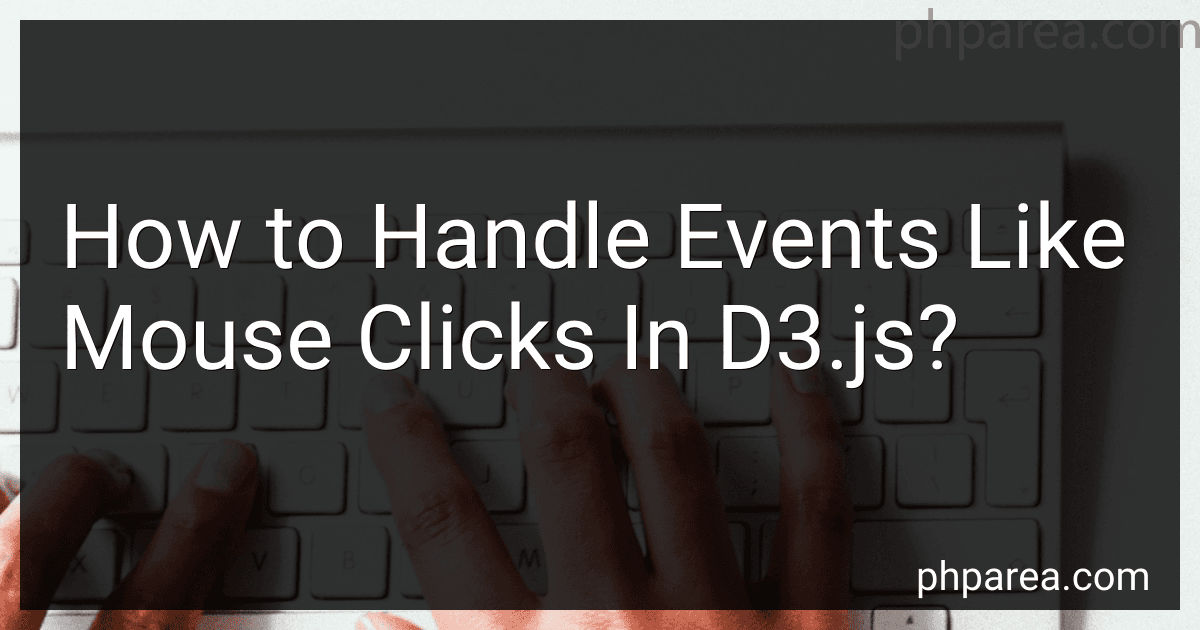Best D3.js Event Handling Guides to Buy in December 2025
In D3.js, you can handle events like mouse clicks by attaching event listeners to your elements or SVG shapes. These event listeners allow you to define specific actions or functions to be executed when a particular event, such as a mouse click, occurs.
To handle mouse click events in D3.js, you can use the .on() method to attach a click event listener to an element. For example, if you have a <circle> element that you want to respond to mouse clicks, you can use the following code:
d3.select("circle") .on("click", function() { // Code to execute when the circle is clicked console.log("Circle clicked!"); });
In this code snippet, d3.select("circle") selects the <circle> element. The .on() method attaches the event listener for the "click" event. Inside the function provided to .on(), you can define the actions you want to take when the element is clicked.
You can also pass additional parameters to the click event function. The first parameter typically refers to the event itself, allowing you to access properties like the mouse coordinates. For example:
d3.select("circle") .on("click", function(event) { // Code to execute when the circle is clicked console.log("Circle clicked at coordinates:", [event.clientX, event.clientY]); });
In this modified code, the event parameter provides access to the event properties. Using event.clientX and event.clientY, you can log the coordinates of the click position.
Remember that you can attach event listeners to any SVG shapes or elements you create in D3.js, not just circles. Additionally, you can attach multiple event listeners to an element, allowing you to handle various events like mouseover, mouseout, etc., with different actions or functions.
How to trigger a custom event in D3.js?
To trigger a custom event in D3.js, you can use the dispatch module. Here's an example of how to do it:
- First, import the dispatch module from D3.js:
import { dispatch } from 'd3-dispatch';
- Initialize a new dispatcher:
const customEvent = dispatch('eventName');
- Trigger the custom event when desired:
// Trigger the custom event customEvent.call("eventName", this, eventArguments);
The above code creates a custom event called "eventName" and triggers it by calling customEvent.call("eventName", this, eventArguments);. Replace "eventName" with your desired event name and provide any necessary arguments to the event.
You can also create multiple custom events by adding additional event names to the dispatch() function, separated by commas. For example:
const customEvents = dispatch('event1', 'event2', 'event3');
Then, you can trigger each event individually using customEvents.call().
How to handle keyboard events in D3.js?
In D3.js, you can handle keyboard events by using the d3.select() or d3.selectAll() methods to select the DOM elements you want to listen for events on, and then attaching event listeners to them.
Here's an example of how to handle keyboard events in D3.js:
- Select the DOM element(s) you want to listen for keyboard events on. For example, you can select the whole document or a specific element by its ID:
// Select the whole document var body = d3.select("body");
// or select a specific DOM element by its ID var element = d3.select("#myElementId");
- Attach an event listener to the selected element(s) using the .on() method. Specify the event type as "keydown" or "keyup" to listen for keyboard events:
body.on("keydown", function(event) { // Handle keydown event here });
element.on("keyup", function(event) { // Handle keyup event here });
- Access the key code or key name from the event object inside the event handler function to determine which key was pressed or released:
body.on("keydown", function(event) { var keyCode = event.keyCode || event.which; var keyName = event.key;
// Example of handling a specific key if (keyCode === 13) { console.log("Enter key pressed"); } });
element.on("keyup", function(event) { var keyCode = event.keyCode || event.which; var keyName = event.key;
// Example of handling a specific key if (keyName === "Escape") { console.log("Escape key released"); } });
- You can then perform any necessary actions or update your visualization based on the key events.
Note that the event object passed to the event handler function may differ slightly between different browsers, so it's a good practice to handle both event.keyCode and event.which to ensure cross-browser compatibility.
Also, make sure to properly remove event listeners when they are no longer needed, to avoid memory leaks.
How to select elements in D3.js?
In D3.js, you can select HTML elements using various methods. Here are some of the commonly used selection methods:
- select(): This method selects the first matching element that matches the specified CSS selector. For example: d3.select("body") // selects the element
- selectAll(): This method selects all matching elements that match the specified CSS selector. For example: d3.selectAll("circle") // selects all elements
- attr(): This method is used to get or set the attribute of the selected element. For example, to set the fill color of a selected circle element: d3.select("circle").attr("fill", "red")
- style(): This method is used to get or set the CSS style property of the selected element. For example, to set the font size of a selected text element: d3.select("text").style("font-size", "20px")
- data(): This method is used to join and bind data to selected elements. For example, to bind an array of data to a selection of circles: var data = [1, 2, 3, 4, 5]; var circles = d3.selectAll("circle").data(data)
These are some of the basic methods for selecting elements in D3.js. There are many more selection methods available to manipulate and interact with the selected elements.
